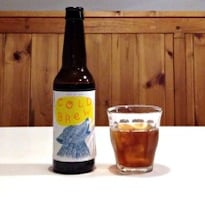This summer, cutting-edge coffee has been all about cold-brew, a centuries-old brew method that offers coffee geeks fresh nuances in flavour. And it is one that you can easily try at home. But why is it getting baristas so excited?
In 2014, keeping pace with coffee can be an exhausting business. First came the flat white, then an explosion in drip-filter. Suddenly, the Aeropress was everywhere and, this summer, British coffee connoisseurs have been hailing a new breakout star: cold-brew.Not to be confused with iced-coffee (in which hot or chilled espresso-based coffees are served over ice, often with milk and syrup), cold-brew is very much what it says on the tin. Coffee grounds are steeped in room-temperature water for up to 24-hours to produce a concentrated coffee essence which is then diluted with water, usually by 50%, and served chilled.From seemingly nowhere, every third-wave coffee bar worth its salted caramel shortbread is on the case, from East London's Timberyard to Edinburgh's Brew Lab. Why? Because cold-brew produces a sweeter, less acidic drink which, certainly in the summer months, delivers a satisfying coffee flavour but in a new, refreshing format.Wayne Lew, co-owner of Manchester's North Tea Power, which has recently been selling 200 bottles of cold-brew each week (at £3.50 each), says it is difficult to pinpoint quite why it has taken off this summer. He has been producing it, at a low-level, for four years, but, this year, interest has rocketed. It is just one manifestation, suggests Lew, of Britain's rapidly expanding interest in coffee: "Perhaps, once people have learned about one brew method they become interested in others. I remember when we set up the brew bar with the V60s, there weren't any of those about, so it was interesting to see that being done. We've always had the cold-dripper on the counter throughout summer, and people who wanted to ask about it would."
Make your own cold brewIn Japan, cold-brew is produced in handsome, slow glass-drippers, but you can easily replicate the effect at home. Take 120g-180g of coarsely ground, preferably single-origin coffee (you can tinker at pretty much every stage of this process to produce slight variations in the end product), and place that in a jug filled with a litre of water, fully immersing the coffee in it. Tightly cover the jug with cling film and either store it at room-temperature or in the fridge for around 16 hours. Two or three times, agitate the jug a little, to move the grounds around. Then slowly double or triple-filter the brew (North Tea Power uses nylon first and then a paper filter), until you have cleaned the brew of the visible spent coffee grinds. Like all filter coffees, it is comparatively high in caffeine at that point, so, in order that you do not end-up bouncing off the walls, it needs to be let down with around 50% water and then chilled, before serving - over ice if you wish.Cold Brew ... for cool customers only?
In 2014, keeping pace with coffee can be an exhausting business. First came the flat white, then an explosion in drip-filter. Suddenly, the Aeropress was everywhere and, this summer, British coffee connoisseurs have been hailing a new breakout star: cold-brew.Not to be confused with iced-coffee (in which hot or chilled espresso-based coffees are served over ice, often with milk and syrup), cold-brew is very much what it says on the tin. Coffee grounds are steeped in room-temperature water for up to 24-hours to produce a concentrated coffee essence which is then diluted with water, usually by 50%, and served chilled.From seemingly nowhere, every third-wave coffee bar worth its salted caramel shortbread is on the case, from East London's Timberyard to Edinburgh's Brew Lab. Why? Because cold-brew produces a sweeter, less acidic drink which, certainly in the summer months, delivers a satisfying coffee flavour but in a new, refreshing format.Wayne Lew, co-owner of Manchester's North Tea Power, which has recently been selling 200 bottles of cold-brew each week (at £3.50 each), says it is difficult to pinpoint quite why it has taken off this summer. He has been producing it, at a low-level, for four years, but, this year, interest has rocketed. It is just one manifestation, suggests Lew, of Britain's rapidly expanding interest in coffee: "Perhaps, once people have learned about one brew method they become interested in others. I remember when we set up the brew bar with the V60s, there weren't any of those about, so it was interesting to see that being done. We've always had the cold-dripper on the counter throughout summer, and people who wanted to ask about it would."
Advertisement
Advertisement
Make your own cold brewIn Japan, cold-brew is produced in handsome, slow glass-drippers, but you can easily replicate the effect at home. Take 120g-180g of coarsely ground, preferably single-origin coffee (you can tinker at pretty much every stage of this process to produce slight variations in the end product), and place that in a jug filled with a litre of water, fully immersing the coffee in it. Tightly cover the jug with cling film and either store it at room-temperature or in the fridge for around 16 hours. Two or three times, agitate the jug a little, to move the grounds around. Then slowly double or triple-filter the brew (North Tea Power uses nylon first and then a paper filter), until you have cleaned the brew of the visible spent coffee grinds. Like all filter coffees, it is comparatively high in caffeine at that point, so, in order that you do not end-up bouncing off the walls, it needs to be let down with around 50% water and then chilled, before serving - over ice if you wish.Cold Brew ... for cool customers only?
Advertisement
For the latest food news, health tips and recipes, like us on Facebook or follow us on Twitter and YouTube.
Advertisement
